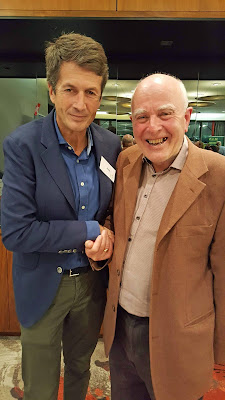John Wilson’s Beaujolais Master Class
“A Wine That Made Me Sit Up And Take Notice!”
 |
| Contre Jour |
“Beaujolais was one of the first wines that made me sit up and take notice,” said John Wilson as he introduced last Wednesday’s Beaujolais masterclass in Cork’s Clayton Hotel.
He also admitted to being a rather cocky student at the time, maybe a bit like Beaujolais Nouveau but, like a good wine, has matured and his smooth style was very much in evidence during a very informative and well-paced session.
He didn't think that the annual wave of Nouveau did the wine much good in the long run. “Beaujolais has been through a rough time..because of the big concentrated wines that were prevalent for a long time. Its style went out of fashion. Now it's back. Its time has come again!”
“Nowhere is terroir more important. That interesting soil, the purity of the grape and quite simple wine-making leads to an easy drinking fruity wine. That doesn't mean that Beaujolais can’t be serious. I've been tasting some 2008 and 2009 Moulin À Vent recently and it is drinking like a dream. Beaujolais offers great value and a quite unique style.”
He took us through the three areas of the region. The east, with its granite, has all ten crus. “There are a huge number of small estates, including Jadot; it is the home of natural winemaking.” Gamay is “never short of acidity. You’ll love it if you like a refreshing style.”
 |
| #gogamaygo |
Recent vintages were also touched on. Under-rated and excellent summed up 2014. Outstanding and exceptional, one of the best ever, were the words for 2015, “but do watch out for the high alcohol!”. The 2016 crop was badly hit by hail in May but there is a lot of promise in the reduced output as the wines are “fresh and forward with good supple fruit”.
John himself is a bit sceptical about the importance attached to “great vintages”. “There is no such thing as a great vintage but there are great winemakers. Always go to the winemaker!”
 |
| The granite's different colours |
The Wines
 1: Beaujolais blanc, Mommessin, Les Grandes Mises. This 2014 has “developed a bit and is a pretty nice food wine”.
1: Beaujolais blanc, Mommessin, Les Grandes Mises. This 2014 has “developed a bit and is a pretty nice food wine”.
2: Beaujolais rosé, Chateau de Corcelles, Rosé d’une Nuit 2016: Bone dry, “another one for food”.
3: Beaujolais, Domaine du Vissoux, ‘Les Griottes’ 2016: “A classic entry level.. acidity freshness, moreish.” This one certainly made me sit up and take notice!
4: Beaujolais Villages Domaine des Nugues 2014: “A wonderful wine, almost better than Fleurie.” I loved the finish, the purity of the fruit.
 |
| Red dominates in Beaujolais. |
5: Régnié Les Vins Henry Fessy, Chateau des Reyssiers 2015: the first of the crus, “one of the most 'granitic'. A wine to drink young. Note the concentration, texture and tannin.”
6: Chiroubles Chateau de Javernand Vieilles Vignes 2015: From a small cru, almost 100% pink granite. Light, elegant, floral and fresh “one of the most interesting and enjoyable that I have come across.” And they are looking for an Irish importer!
7: Saint-Amour Maison Trénel 2015: “Always does well in February,” joked John. “The estate is now owned by M. Chapoutier.” This was perhaps my favourite of the first round.
8: Brouilly Jacques Charlet 2015. We started round two with this lovely light perfect easy drinking wine grown on soils that include blue granite. Again, John stressed that easy drinking does not necessarily mean a simple wine.
9: Fleurie Domaine de la Madone, Tradition 2015. “Very aromatic, floral, silky, but with great concentration… very fond of it. Will keep. Tasted the ten year old and it is great.” For me, this was simply superb.
10: Côte de Brouilly Jean-Paul Brun, Domaine des Terres Dorées 2015: “One of the best winemakers there. Distinctive nose..light but with length. He also makes excellent Crême de Cassis and Crémant”. I was amazed at the aromas, the concentration and the finish of this Wines Direct import.
11: Juliénas Domaine de la Conseillère 2014: “not too much granite here and a distinctive wine.” Super fruit and smooth with great finish, another star for me. John puts its excellence down to a combination of the Burgundian wine-making style employed and the Juliénas effect.
12: Chénas Pascal Aufranc, Vignes de 1939, 2016: “from a single vineyard, going the organic route, this has silky aromas and velvety texture.” I found it another excellent drop with a lip smacking finish and the second glass effect.
13: Morgon Dominique Piron, Côte du Py 2014: “Completely different..powerful concentrated wine. Needs another few years , or a steak!”. Indeed it probably needs more time, one to put away. John reckons both this and Moulin À Vent will both age well.
14: Moulin À Vent Chateau des Jacques 2012: A challenging vintage from the best known cru. Vineyard owned by Louis Jadot since 1996. “Again a Burgundian style, oak included… the colour is towards Pinot Noir.” Perhaps my favourite overall. I found it much more approachable at this point in time than the Morgon.








































